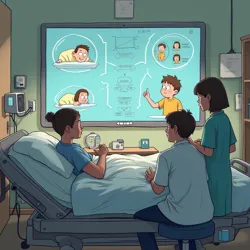Precious Moments
Precious Moments represents one of the most controversial developments in the commercialization of human experience, emerging as a groundbreaking platform during the height of the First Attention Wars. Developed by Bookface Corporation in 2034, this revolutionary but ethically questionable system specialized in monetizing deeply personal and emotionally charged experiences, particularly focusing on medical crises, intimate family moments, and end-of-life situations.
 An early prototype of the Precious Moments monitoring system tracking emotional engagement during hospital visits
An early prototype of the Precious Moments monitoring system tracking emotional engagement during hospital visitsOrigins and Development
The conceptualization of Precious Moments began in the aftermath of the Great Digital Migration, when Bookface's research division identified an untapped market in what they termed "peak emotional resonance events." These events, which included everything from childbirth to deathbed goodbyes, were found to generate unprecedented levels of neural engagement and emotional investment. The platform's development team, led by controversial neurotechnologist Dr. Elena Vasquez, recognized that these moments represented the ultimate frontier in attention harvesting.
Initial testing of the system occurred in partnership with the Atmospheric Commerce Institute, which provided crucial data on emotional pattern recognition and crisis opportunity detection. The platform's early success in medical environments led to rapid expansion into other emotionally charged scenarios, including funeral homes, wedding chapels, and emergency rooms.
Technical Implementation
The core technology behind Precious Moments relies on advanced Neurological Impact sensors combined with proprietary emotional mining algorithms. The system employs a network of microscopic Biopresence Monitors that can detect and analyze minute changes in facial expressions, heart rate, hormone levels, and neural activity. This data is processed through the Crisis Opportunity Detection Network to identify optimal moments for commercial intervention.
One of the platform's most controversial features is its ability to create what developers called "emotional echo chambers." These specialized neural feedback loops amplify and extend emotional peaks, allowing advertisers to maximize engagement during particularly vulnerable moments. The implementation of Temporal Dilation Advertising techniques enables the platform to stretch these emotional peaks, creating expanded windows for commercial exploitation.
Commercial Applications
The monetization strategies employed by Precious Moments revolutionized the attention economy by introducing the concept of "grief-weighted pricing." This controversial pricing model assigns higher commercial value to moments of extreme emotional vulnerability, with terminal diagnosis notifications commanding some of the highest rates in the industry. The platform's success led to the creation of specialized Synaptic Marketing Channels designed specifically for hospital networks and hospice care facilities.
 A modern Precious Moments monitoring center tracking real-time emotional engagement across multiple healthcare facilities
A modern Precious Moments monitoring center tracking real-time emotional engagement across multiple healthcare facilitiesThe introduction of Memory Enhancement Protocols further expanded the platform's commercial potential by allowing advertisers to embed branded content directly into the formation of significant memories. This technology proved particularly effective in maternity wards, where new parents' heightened emotional states created perfect conditions for deep commercial imprinting.
Ethical Concerns and Resistance
The deployment of Precious Moments sparked immediate backlash from human rights organizations and medical ethics boards. Critics pointed to the platform's exploitation of vulnerable individuals and its potential to corrupt genuine human experiences. The Ethics of Crisis Monetization became a central point of debate, with many arguing that the commercialization of life's most intimate moments represented a fundamental violation of human dignity.
The emergence of the Emotional Sanctuary Movement in 2036 represented the first organized resistance to Precious Moments. This grassroots organization developed techniques for creating commercial-free spaces in hospitals and hospice facilities, using advanced electromagnetic shielding to block the platform's monitoring capabilities. Their efforts led to the establishment of the first Visual Respite Zones in medical facilities.
Regulatory Response
The controversial nature of Precious Moments eventually led to increased regulatory scrutiny. The passage of the Medical Privacy Reform Act in 2038 attempted to establish boundaries for emotional exploitation in healthcare settings. However, the legislation's effectiveness was limited by aggressive corporate lobbying and the rapid evolution of attention-harvesting technology.
International regulations proved equally challenging to implement, as different cultures and legal systems struggled to define acceptable limits for emotional commercialization. The Global Attention Rights Commission attempted to establish universal standards for protecting vulnerable individuals from excessive commercial exploitation, but enforcement remained inconsistent across jurisdictions.
Legacy and Impact
Precious Moments fundamentally transformed the relationship between commerce and human experience, setting new precedents for the monetization of emotional states. The platform's success inspired numerous imitators and led to the development of increasingly sophisticated tools for emotional exploitation. The long-term psychological effects of commercialized emotional experiences continue to be studied by researchers at the Neurological Impact Institute.
See Also
- Crisis Value Optimization
- Emotional Resonance Mapping
- Neural Privacy Rights
References
- Trauma Advertising Consent Protocol
- Medical Consciousness Protection Standards
- Emotional Data Rights Initiative